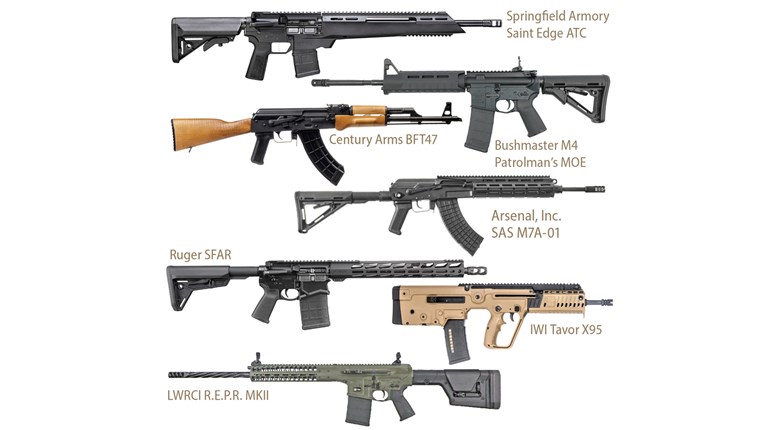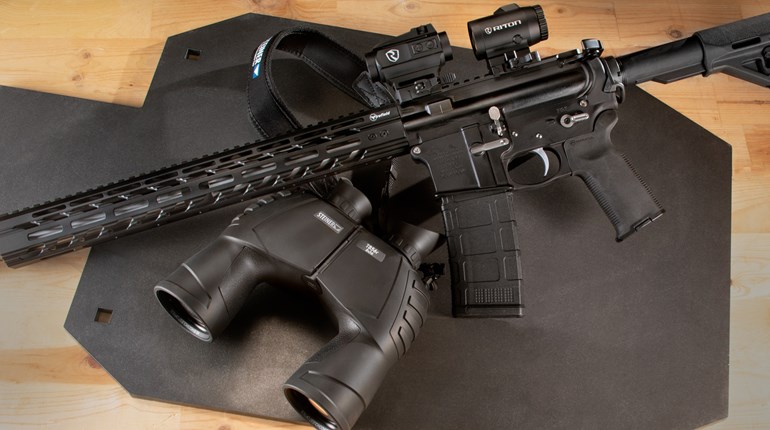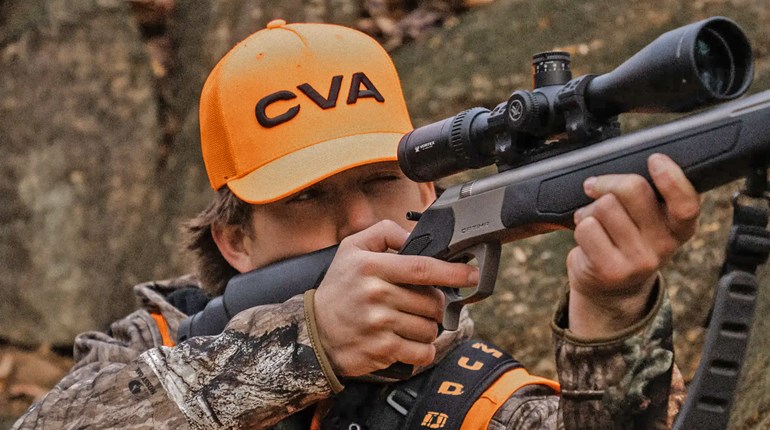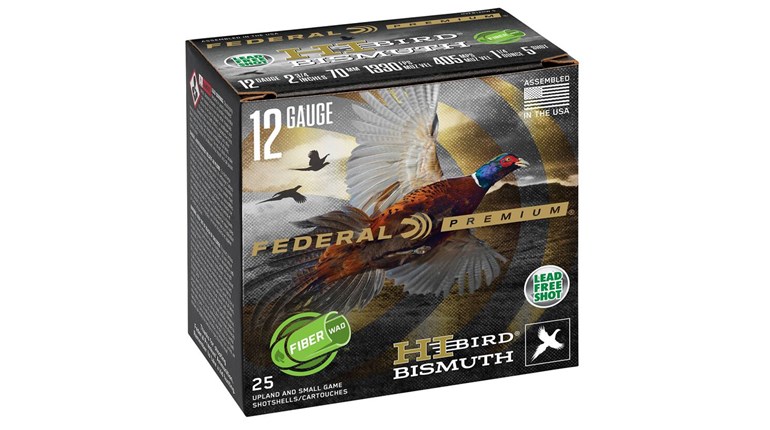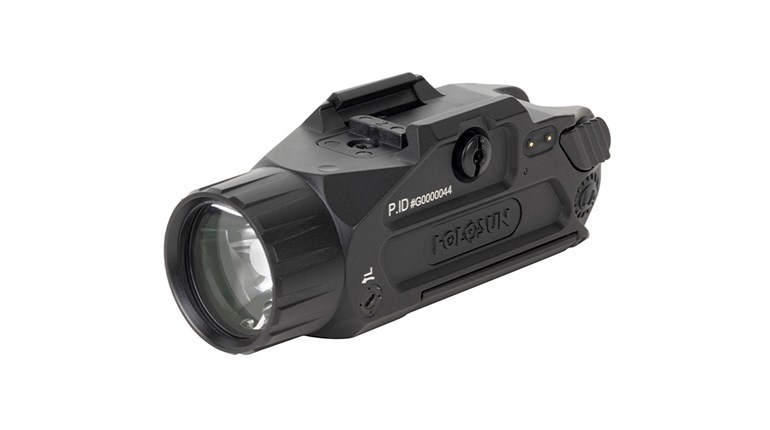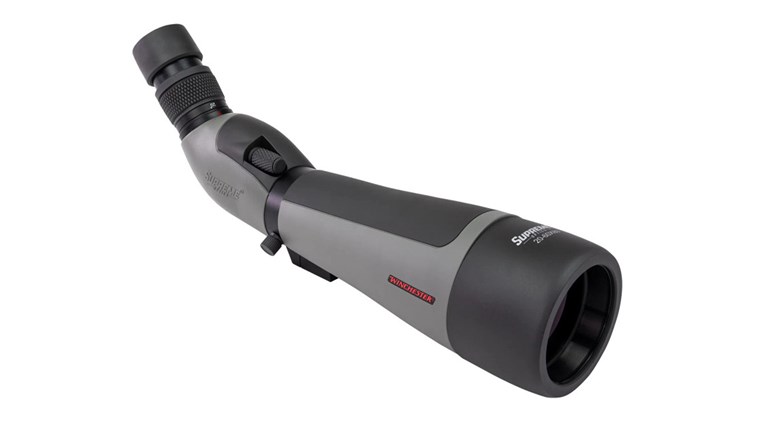
Nowhere is the AR-15 platform’s popularity more apparent than on the racks of gun stores around the country. Even in those regions where semi-automatics take a backseat to traditional lever-action and turnbolt hunting rifles, most gun shops can count on at least one AR “turn” a week. The good news for buyers is that AR supply and demand is the same as that of any other product: More available AR rifles, carbines, SBRs and pistols equal more consumer options and better pricing. The bad news is that the process of sorting through all these choices can be daunting. The prospective AR buyer’s options include premium models costing a month’s pay, full custom builds, moderately priced package guns and entry-level carbines in a variety of calibers. It is the last category that has lately piqued my interest in terms of both value and performance.
Most of the ready-built guns I encounter in the course of business come from companies well-known to the AR community like Bravo Company, Colt, LMT, Smith & Wesson, SIG Sauer, LaRue Tactical, Knight’s Armament, Armalite and a few others. These guns generally only need minor tweaks to improve performance, but in some cases more extensive work is required to correct something that slipped through the quality-control cracks.
My experience has always been that if your new gun has functional problems, you should first contact the manufacturer and seek help under the warranty. Any reputable company will work quickly to get its product operating as designed. When systemic problems pop up within a specific brand or model, it usually leads to a bad rep that spreads around the Web like poison sumac on a sweaty July day. As long as the issues are fairly represented, this is a good thing in my opinion, because it keeps firearm manufacturers—of which I am one—honest and accountable for our products. Aside from needed fixes, basic user-modifications to any such rifles can improve ergonomics measurably, while more extensive gunsmith work can bring them to custom-performance levels.
Recently, I got the itch to see if an AR from the lowest cost tier could hold its own as a basic bullet launcher. Hunting around for sales can get you one of these carbines for $600 to $700, give or take a bit depending on model and region. They typically are very basic, small-frame ARs chambered in 5.56 NATO. Cheap M4-style stocks, A2 pistol grips, flash hiders and two-piece handguards are the norm. A magazine may or may not be included, and if it is advertised as “Optics Ready” that means you provide the sights or optic. Barrels are often 1:9-inch twist and just as often made of unlined chrome-moly. Sometimes you can find an upgrade or two thrown in to sweeten the pot, which is what happened as I looked at candidates for this effort. I intentionally selected a brand that has received its share of good and bad reviews and a model that had a couple of nice extras and a low price. I did not intend this to be a review, but rather a quick assessment of entry-level AR performance. So, instead of arranging for a test sample, I bought the carbine—a Radical Firearms RF-15—from a distributor, just as any other FFL holder would.
This carbine has what I consider to be the minimal bells and whistles needed for a stock carbine to have a decent chance of shooting well without substantial modifications. My goal was to assess the rifle right out of the box, then keep any needed tweaks at the most basic level in terms of both skill and tooling required. I did not exactly succeed in that aim, and what I found was a mixed bag of surprises, good and bad.
The RF-15 is pretty standard for a 5.56 NATO-chambered AR. Its 16-inch chrome-moly barrel is nitrided to provide it good corrosion- and wear-resistance inside and out. The 1:7-inch twist barrel has a 1⁄2x28-threaded muzzle and standard A2 flash hider. I would have just as easily taken a chrome-lined barrel, but since the FNC process (aka Melonite, Black Nitride or just plain nitride) is much less expensive and more uniform than chrome lining, we find it distributed widely across the price spectrum these days. The other key feature I wanted was a freefloated barrel. It is not difficult to change out a set of stock, two-piece handguards with the right tools, but most folks do not want to buy wrenches and bench fixtures just to get one rifle up to par. The RF-15’s fore-end has a full-length top rail with anti-rotation tabs, multiple QD sling sockets and a sort of fluted/heat-sink-type barrel nut similar to those found on some very popular aftermarket fore-ends.

The rifle I purchased had an excellent out-of-the-box trigger assembly. It was a mil-spec-type, single-stage, semi-automatic trigger group, without any of the usual grit and creep associated with stock AR triggers. I would have sworn it is one of the improved mil-spec variants offered in the aftermarket, but I could not find any indications of that. The trigger broke cleanly at 4 pounds, 14 ounces and was very consistent from pull to pull. The rest of the rifle was standard fare—carbine-length gas system, low-profile gas block, M4 collapsible stock, forged lower, flattop upper and a nice Ergo rubber pistol grip. It came with a 30-round magazine, cable lock, flash drive with operator’s manual loaded and enough oil to have soaked portions of the foam in its hard gun box.
Before loading up for testing, I performed a series of inspections and then compared my measurements to a large database I have amassed over the years. The numbers all checked out well enough, with the chamber cut on the long side—pretty standard for rack-grade ARs. I then went over the rifle from buttstock to flash hider, checking to make sure everything was torqued and tightened appropriately.

One of the complaints I have heard about Radical Firearms is that it doesn’t stake its bolt-carrier key screws and, in some cases, have shipped rifles with loose screws. My sample gun had no such problems—the screws were properly torqued and staked. However, the castle nut that holds the receiver extension (aka buffer tube) tight was hand tight at best. I am continually amazed at how often I see this problem on new guns and it seems to be unrelated to price point. Rifles that cost six times as much as this one have come to me with loose castle nuts. Fortunately, the problem can be remedied with a couple drops of thread-locking compound like Loctite or Rocksett and a buttstock wrench that costs around $10.
Since I planned to do multiple range tests, I trimmed the usual accuracy-testing protocol down to three each, five-shot groups per range test after confirming zero and cleaning the bore each time. I started things off by breaking in the barrel, firing a series of shoot-and-clean groups until I hit the 60-round mark and saw it was cleaning up quickly before I progressed to group shooting.
Right off the bat I had a problem with the bolt not locking back on an empty magazine and occasionally short-stroking, where it would cycle, eject a spent case, but not move far enough rearward to pick up the next cartridge, closing on an empty chamber. Several conditions can lead to this problem, but the two most common are a weak magazine-follower spring or too little gas pressure in the operating system. Multiple new and used magazine swaps yielded no change in performance, so for the duration of this first test I continued to fire groups, hand-cycling the next round into battery every so often. Of 104 rounds fired on the first outing, I experienced four failures to feed with the bolt closing on an empty chamber and failures to lock back on all empty magazines. This is unacceptable for any new firearm, regardless of cost.

After a thorough cleaning I took a closer look at the gas system. When I performed my initial inspection I noticed the gas tube was binding very slightly in the bolt carrier’s key, but not enough to prompt a correction at that point. You can easily perform this inspection on any direct-impingement AR. Start by unloading and clearing the rifle, and then separate the upper and lower receivers. Next remove the charging handle and bolt-carrier group from the upper. Strip the bolt carrier completely off the bolt, firing pin, cam pin and retaining pin. Then reinsert the bolt carrier (stripped, no charging handle) into the receiver and push it forward slowly by hand. In a perfect world, you will not feel any resistance as the end of the gas tube slides into the carrier key. In reality, you will almost always feel a slight bump as they first align. If that bump is more like hitting a brick wall or if you feel it binding and getting increasingly tight as the carrier moves forward, the tube is out of alignment. Fixes for this condition include carefully bending the last inch or so of gas tube, removing and correcting the tube’s angles with a brake-line bender or loosening and remounting the gas block. Anything beyond a slight bend correction is best left to a gunsmith in order to avoid more trouble.
Before removing the slight gas-tube bind, I used a bore scope to look at the alignment of gas ports between the barrel and the gas block from the inside, which is something my original bore-scope inspection did not check. I was dismayed to see that although the right-to-left alignment was good, front to back was not. This is very uncommon in my experience, but when encountered, it is normally corrected by loosening the gas-block screws, lining up the two ports visually (via bore scope) and tightening the block back down. This, however, was not a normal case. The RF-15’s gas block was fully rearward on the barrel’s journal, butted up to the gas block seat. But the gas block’s port still needed to come back farther in order to align with the barrel’s gas port. I removed the gas block to measure the hole spacing and discovered the RF-15’s gas port was drilled into the barrel too close to the gas block seat. There are several ways to correct this, but I chose the simplest: slightly enlarging the gas port.

Simple does not mean best. If I were servicing this rifle I would have instead faced the rear of the gas block, shortening it and bringing the gas port rearward along the barrel. Secondary to that would be to use a lathe to turn the shoulder back so the gas block can seat further to the rear. Both of these methods require machinery that most folks do not have, but a barrel’s gas port can be enlarged very carefully with a hand drill and correctly sized bit. You must carefully follow the original port channel, keeping the bit squared to the bore. Also, take care not to let the tip of the bit hit the inside of the bore once through because it will leave a gouge in the barrel’s rifling.
The other two machining solutions usually require shortening the gas tube, whereas enlarging the barrel port does not. It is always best to move up in very small increments when opening up a gas port—you can always continue to step up with larger bits, but if you go too far, you cannot put that metal back. So after growing the aperture from .077 to .080 inch, I reseated the gas block and again used my bore-scope to align the ports. While still not perfect, they were nevertheless much closer than before. Next I carefully corrected the gas tube’s bends to create a no-friction gas tube/carrier key fit and headed back to the range.

Things got a little smoother during the second range session. I did not experience any failures to feed or closing on an empty chamber, but the failures to lock back on empty magazines continued. Nonetheless, grouping was more fluid this time due to the lack of hand-cycling interruptions. My groups tightened up slightly with one ammo type and stayed pretty much the same with the other. I elected at this point to not make any more gas-system modifications because the whole idea of the project was to do minimal ’smithing in the first place.
I did, however, make two changes to the rifle’s handling components before heading out for the next test. I replaced the already good trigger with a great, two-stage, match, drop-in trigger unit from Geissele. I selected a Super Dynamic Enhanced trigger because it is excellent for precision shooting, but still usable for close-range/rapid work. I also swapped the A2 flash hider/comp for an inexpensive but effective Miculek muzzle brake. This part retails for around $40 and is one of the best values on the market. Neither modification is particularly difficult, but changing muzzle devices does require care to avoid damaging the firearm and a chamber-support tool is very helpful. These enhancements were not required to make the inexpensive rifle functional—I installed them only to gauge the accuracy potential of the RF-15’s stock barrel. Finally, I decided to also change the bolt stop from Radical Firearms’ fancy one to a stock unit from DPMS. I did so because although the RF-15’s bolt stop had a nicely textured release pad on the outside, the inside was another story. I am pretty sure my test rifle’s bolt stop was “sculpted” on the inner surfaces with some sort of rotary tool. The tiny die-grinder marks all over the catch portion were crude enough to embarrass a one-eyed Pakistani arms cloner. I replaced it just in case it was contributing to the bolt-lock-back issue.
Test number three went much better than the previous two. Initially the bolt failed several times to lock back when empty, but only when using one of my very well-travelled “veteran” magazines. After changing to all-new mags, that problem disappeared completely and no other functional issues were experienced. My accuracy improved significantly with the new trigger and brake, with groups averaging nearly 1-MOA smaller in each case. I put a total of 280 rounds through the rifle with the only problems being those already noted.
I have mixed feelings about this whole project. The rifle I selected came with a freefloated barrel and a decent trigger, both of which are unusual at its price point. The rack-grade barrel is clearly capable of excellent accuracy. But, the rifle was not fully functional without work right out of the box, and that is unacceptable in my opinion. Thankfully, the minor modifications I performed eventually got things running well enough to get through a test without problems. At present, the rifle still needs more work, but we’re at the ‘smith level for that.
The good news is that the functional tweaks I made to get the RF-15 running only cost me time and test ammo and can be done by anyone with a little mechanical skill—of which I am living proof—and the ability to follow instructions. Even with the stock trigger and flash hider, this rifle shot a couple of sub-MOA groups and was battle-rifle accurate with factory ammunition at 100 yards. It could easily be made into a decent carbine without much investment beyond the purchase price. I think it is worth the money only if you are willing to troubleshoot it right out of the box. It is possible I simply bought a lemon, especially since I have found more positive reviews of this rifle than negative. You can find a few other options in the sub-$650 price range or jump to the $700 to $1,000 category and get a major-brand carbine that is more likely to be problem-free out of the box, but with fewer add-ons.
My advice? If you want to make a minimal investment, the low-end ARs are worth a look. But if this rifle is going to immediately be relied on for defensive duties, pay a bit more, trade some of the attractive features for better reliability, then upgrade later as your time and budget permit.













